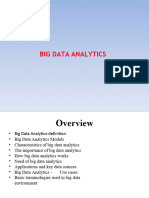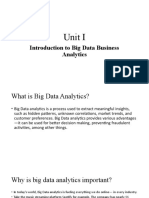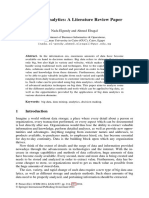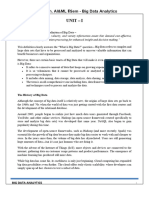0% found this document useful (0 votes)
27 views6 pagesBig Data and Data Analytics
Big Data refers to large and complex datasets that require specialized tools for analysis, originating from transactional, machine, and social data. It encompasses structured, semi-structured, and unstructured data, offering advantages like enhanced decision-making and improved customer insights, while also posing challenges such as privacy concerns and data quality issues. The future of Big Data analytics includes real-time analytics, advanced predictive models, and the potential of quantum computing.
Uploaded by
Vishali NarayananCopyright
© © All Rights Reserved
We take content rights seriously. If you suspect this is your content, claim it here.
Available Formats
Download as PDF, TXT or read online on Scribd
0% found this document useful (0 votes)
27 views6 pagesBig Data and Data Analytics
Big Data refers to large and complex datasets that require specialized tools for analysis, originating from transactional, machine, and social data. It encompasses structured, semi-structured, and unstructured data, offering advantages like enhanced decision-making and improved customer insights, while also posing challenges such as privacy concerns and data quality issues. The future of Big Data analytics includes real-time analytics, advanced predictive models, and the potential of quantum computing.
Uploaded by
Vishali NarayananCopyright
© © All Rights Reserved
We take content rights seriously. If you suspect this is your content, claim it here.
Available Formats
Download as PDF, TXT or read online on Scribd
/ 6



























































































